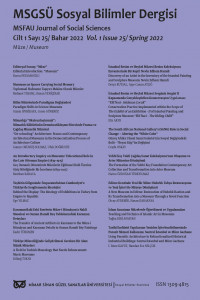Mülteci Olmayı Kim Hak Eder? : Ukraynalı Mültecilerin Sosyal Medyada Dayanışma Söyleminde Sanat ve Kültürün Araçsallaşması
Bu makale; kültürel pratiklerin ve sanatsal yetenek gösteriminin, Rusya’nın 2022 Ukrayna saldırısına karşı Ukrayna direnişini desteklemek ve Ukraynalı mülteciler ile dayanışmak amacıyla kullanımını inceler. Aidiyet söylemi “biz” ve “onlar” ayrımları üzerinden kullanıcılar tarafından sosyal medyada başka bir araç veya temsile gerek kalmaksızın inşa edilebilmektedir. Bu makale, Ukraynalıların haklı tanımlanan direnişlerini ve anavatanlarından ayrılma zorundalıklarının çevrimiçi dayanışma paylaşımları altında nasıl da sanat, sanatsal pratikler ve kültürel faaliyetler üzerinden temsil edildiğini analiz eder. Bu sosyal medya kullanıcıları, mültecileri medeniyetin bir parçası olarak göstermekte ve dolayısıyla mültecileri “çıplak yaşam (bare life)” konumuna indirgememek için özel aidiyet söylemi kullanmaktadır. Bu araştırma eleştirel çokludüzlem söylem analizini esas alır. Bu çevrimiçi temsiller, Ukraynalı mülteciliğini ve savaş sonrası yerinden edilmiş bireyleri geride kalmış yoksul küreselleşen güney kesiminden gelmesi alışılagelmiş göçmen ötekileştirmesinin dışına çıkarır. Çünkü bu dayanışma söyleminde Ukraynalı mülteci tahayyülü entelektüel aktivite (logos) ile özdeşleşir.
Who Deserves to be Refugee? : The Instrumentalization of Art and Culture in the Solidarity Discourse of Ukrainian Refugees in Social Media
This article explores the online display of artistic ability and cultural practice to express support for the resistance in Ukraine and Ukrainian refugees while blaming the Russian attack on the country starting in 2022. Social media engagement is essential in constructing discursive traits of belonging through bottom-up articulations of ‘us’ and ‘them’ dichotomies. Here, I question the distinguished characteristics of representation related to art, artistic practices, and abilities under solidarity social media posts in the case of Ukrainians fleeing their homes. Social media users who include art and culture concerning solidarity use a discourse of inclusion and exclusion to depict refugees as parts of civilization and hence not reducible them to the bare life position. This study is guided by critical multimodal discourse analysis. I contend that these social media posts that convey specific art and culture-related representations serve to distinguish characteristics of war-torn Ukraine, people displacement, and Ukrainian refugees from the generic tendencies of otherization reflected on the ‘Southern’ refugee figure deprived of capability or motivation for logos.
Keywords:
REFUGEE, MIGRATION, SOCİAL MEDIA REPRESENTATIONS, UKRAINE, ART,
___
- Agamben, G. (1998). Homo Sacer: Sovereign Power and Bare Life (D. Heller-Roazen, Trans.; 1 edition). Stanford University Press.
- Agamben, G. (2004). The Open: Man and Animal. Stanford University Press.
- Androutsopoulos, J. (2013). Online Data Collection. In C. Mallinson, B. Childs, & G. V. Herk (Eds.), Data Collection in Sociolinguistics: Methods and Applications (2nd ed.). Routledge. https://doi.org/10.4324/9781315535258
- Agamben, G. (1998). Homo Sacer: Sovereign Power and Bare Life (D. Heller-Roazen, Trans.; 1 edition). Stanford University Press.
- Agamben, G. (2004). The Open: Man and Animal. Stanford University Press.
- Androutsopoulos, J. (2013). Online Data Collection. In C. Mallinson, B. Childs, & G. V. Herk (Eds.), Data Collection in Sociolinguistics: Methods and Applications (2nd ed.). Routledge. https://doi.org/10.4324/9781315535258
- Arendt, H. (1979). The origins of totalitarianism (New ed. with added prefaces). Harcourt Brace Jovanovich.
- Arendt, H. (2019). The Human Condition: Second Edition. University of Chicago Press.
- Aristotle. (1997). Poetics (M. Heath, Trans.; New Ed edition). Penguin Classics.
- Aristotle. (2017). Politics: A New Translation (C. D. C. Reeve, Trans.). Hackett Publishing Company, Inc.
- Baker, P., Gabrielatos, C., KhosraviNik, M., Krzyżanowski, M., McEnery, T., & Wodak, R. (2008). A useful methodological synergy? Combining critical discourse analysis and corpus linguistics to examine discourses of refugees and asylum seekers in the UK press. Discourse & Society, 19(3), 273–306. https://doi.org/10.1177/0957926508088962
- Balibar, É. (1991). Race, Nation, Class: Ambiguous Identities. Verso.
- Barberá, P., & Rivero, G. (2015). Understanding the Political Representativeness of Twitter Users. Social Science Computer Review, 33(6), 712–729. https://doi.org/10.1177/0894439314558836
- Bayoumi, M. (2022, March 2). They are ‘civilised’ and ‘look like us’: The racist coverage of Ukraine. The Guardian.
- https://www.theguardian.com/commentisfree/2022/mar/02/civilised-european-look-like-us-racist-coverage-ukraine Bird, S. E. (2011). Are We All Produsers Now? Cultural Studies, 25(4–5), 502–516. https://doi.org/10.1080/09502386.2011.600532
- Bleiker, R., Campbell, D., Hutchison, E., & Nicholson, X. (2013). The visual dehumanisation of refugees. Australian Journal of Political Science, 48(4), 398–416. https://doi.org/10.1080/10361146.2013.840769
- Boltanski, L. (1999). Distant Suffering: Morality, Media and Politics (G. D. Burchell, Trans.). Cambridge University Press. https://doi.org/10.1017/CBO9780511489402
- Bozdağ, Ç. (2020). Bottom-up nationalism and discrimination on social media: An analysis of the citizenship debate about refugees in Turkey. European Journal of Cultural Studies, 23(5), 712–730. https://doi.org/10.1177/1367549419869354
- ISSN: 1309-4815
- Yayın Aralığı: Yılda 2 Sayı
- Başlangıç: 2010
- Yayıncı: Mimar Sinan Güzel Sanatlar Üniversitesi
Sayıdaki Diğer Makaleler
Nihal EMEKLİER, Bilgehan EMEKLİER
İnsan Hakları Bağlamında Göçün Güvenlikleştirilmesi
Suriye’nin “Öteki” Sığınmacıları: Domların Yaşam Deneyimleri
Çağla SALDUZ DORUK, Sinem ARSLANKOÇ, İsmail NALBANTOĞLU, Nurgün KUL PARLAK
Türkiye’de Göç Yönetişiminde Uluslararası Göç Örgütü (IOM)’nün Rolü ve Etkisi
Suriyeli Öğrencilerin Okul Algısı: Süreçte Yaşananlar ve Değişimi
Sosyal Uyumda Kültürlerarası Yaklaşımın Bir Yansıması Olarak Göçmen Meclisleri
Suriyeli Göçmenlere Yönelik Sosyal Mesafeyi Akademiden Okumak: Türkiye Örneği
Avrupa’da Aşırı Sağ Partiler ve Göçmenlere Yaklaşımları; Seçilmiş Örnekler
